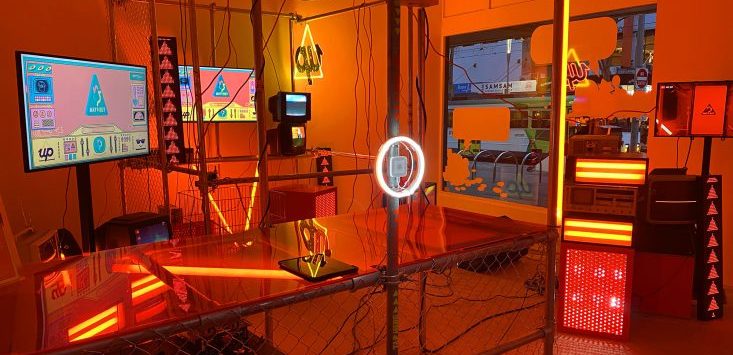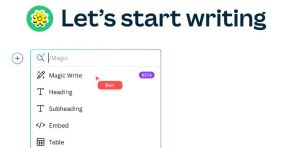
Up's Anti-Impulse Machine at the Maybuy Exchange. Source: supplied
Nothing beats good marketing. It’s entertaining, surprising, memorable, welcomed and makes you feel seen and connected. In an environment that’s more cluttered and competitive than ever before, standing out is no mean feat.
The stats change by the minute, but on average we’re exposed to an average of 7000 ads a day. Though marketing should cover off different objectives throughout a marketing funnel (from awareness to conversion) it’s been proven that brands that aim for fame have the best shot at impacting their bottom line. Put simply, a 10% rise in the fame of a brand will increase market share by a fifth.
This is pretty incredible. For startups that don’t have the budgets to compete with their deep-pocketed competitors, there is no choice but to be bold and ballsy. We’re sure there are many we’ve missed, but here are 10 fame-driving marketing initiatives that we take our hats off to this year.
1. Normal
Operating in the sex industry is a beast. Basic infrastructure like web hosting and payment processing often excludes ‘adult industries’. Not to mention vigilant marketing platforms and their lightning-fast reflexes to remove what they deem ‘inappropriate content’. To circumnavigate this hurdle, at a particularly precious time of year for D2C businesses (hello, Black Friday!), NORMAL created street posters laden with spelling mistakes and blurred imagery of their range of sex toys. The campaign shook a finger at dated censorship laws, and the gendered double standards behind them, while also delivering powerful creative that garnered significant attention. The campaign exceeded all expectations in terms of performance.
“This was our first major campaign for NORMAL since consciously uncoupling from our parent company, and we’re so excited by the reception of the creative — which was a joy to make! — as well as the massive improvements in marketing efficiency we’ve seen, with our marketing spend looking 6-7X more effective!” said Normal Founder and AfterWork community member, Lucy Wark.

Normal poked fun at censorship double standards in a breakthrough street poster campaign.
2. Stranger Things x Dominos: Mind Ordering App
To launch their hotly anticipated season five, Stranger Things went big and weird. The marketing mix was littered with a dynamic mix of activations and partnerships; like a Snapchat filter complete with nosebleeds, or Lyft partnerships with ‘haunted-house-style’ cars chartered by creepy drivers or giant artistic installations of the Mind Flayer in public spaces like Bondi. Perhaps the best initiative was a partnership with Dominos where fans were invited to order a pizza with their mind. The app tracked eye movements and used facial recognition software to allow you to order the perfect pizza without saying a thing. The idea worked for both brands; reinstating Domino’s dominance as a tech player, while giving Stranger Things fans a new way to experience a ‘food group’ they care deeply about.

This mighty partnership gave fans everything they wanted.
3. Ovira’s tattoo for cash
Ovira, the pulse therapy device for period pain relief, have mastered the art of disruptive, breakthrough marketing. It’s on a mission to correct the injustices of female healthcare; and it is starting by challenging the taboo of period pain. In its own words, on its Linked In bio: “We solve shitty women’s problems that society forgot about.” Through a combination of frank, stunt-based activations, amplified through social media, Ovira has quickly amassed almost 6 million followers on TikTok. Not bad for a topic no-one likes talking about! One of its best efforts this year was offering to pay a stranger $500 to get an Ovira tattoo. The willing participant had no idea what Ovira meant but went ahead anyway. This stunt racked up millions of views and hit the press circuit off the back of it.

Ovira’s marketing is a font of uncomfortable truths and endless source of entertainment.
4. Airbnb’s Ukraine campaign
This compassionate business move became an invaluable piece of viral marketing for a business known for its marketing prowess. The company waivered all booking fees for any rental made in the Ukraine, then encouraged people all over the world to book. The goal was to get money directly into citizens’ hands; fast. And it worked, raising nearly $2 million dollars in a month. This initiative was quickly backed up with Airbnb.org’s campaign to fund 100,000 Ukrainian refugees. Airbnb is a stellar example of a business powered by its brand. It champions ‘belonging’ and pull that notion through to all business activities; well beyond its marketing department.

Airbnb’s initiative offered multiple ways to support the people of Ukraine.
5. Patagonia’s new shareholder
In a similar feel-good vein, Patagonia made waves across the world when CEO and founder Yvon Yvon Chouinard announced that his family had decided to make planet Earth the only shareholder of his AU$4.5 billion business. The news piqued global interest, across an impressively diverse range of mastheads, publications, influencers and outlets.

6. “MayBuy” by Up
One of the oldest tricks in the challenger brand playbook is to zag while the others zig. Up took this lesson to heart when it took a big dig at BNPL culture and launched its MayBuy campaign. After conducting research, it discovered 25% of Aussies regretted a BNPL purchase. In response, it released Maybuy; a feature that allows “Upsiders” to create savings plans for items they might want. Once the savings goal is reached, they can purchase the item in full. Or not. To launch the idea, Up ran a pop-up in Melbourne which offered passers-by random cash payments for between $10-$500 for their regretful purchases. The activation allowed Up to ride a controversial conversation about BNPL culture; and ascertain thought leadership for doing so.

Up’s MayBuy campaign takes a stab at BNPL culture.
7. Coinbase’s SuperBowl Ad
When a slot costs you north of US$5 million, you want to make sure you create something people talk about. Coinbase shunned expensive celebrities and witty plot lines and instead bounced a lone QR code across a screen to a generic techno track, in a manner that mimicked DVD screensaver meets Gameboy. 20 million people downloaded the mysterious QR code and received the $15 free in crypto.

Coinbase’s bold decision to hero a bouncing QR code at the Superbowl.
8. The total Milkrun marketing engine
A lot of respect goes out to the Milkrun marketing team for sailing into constant controversy and finding an opportunity to make every interaction with customers a branded opportunity. From jumping on the Mr Men meme train (“Little Miss F*ck It, Rose All Day Baby”), to provocatively referencing it can deliver ‘bags’ to Bondi in less than 10 minutes, to offering social media trolls coupon codes cheekily names ‘LoyalTroll’; it makes a habit of taking risks, piercing complacency and entering pop culture.

MilkRun turn a troll comment into a brand opportunity.
9. Barilla’s Spotify playlists
Before you throw your hands up in the air and think you need serious budgets to make a difference, let’s hear it for low-cost, high-touch activations! Pasta brand Barilla took to the Spotify airwaves to create eight playlists, named after different pasta types. Each playlist was timed to match the required cooking time of each pasta; with names like Boom Bap Fusilli,” “Moody Day Linguine,” and “Pleasant Melancholy Penne”. This simple activation was genuinely useful and deeply engaging.

Barilla’s pasta playlists were a low cost, high-impact and strong brand building initiative.
10. Iceland Tourism’s Outhorse Your Email campaign
Iceland has built its brand off the back of its dramatic scenery and quirky national character. In its 2022 tourism campaign, Iceland merged both these elements. In a spectacular display of absurdism, underpinned by a real insight (nothing ruins a holiday like an email from your boss). So the tourism board trained three horses to reply to your emails while on holiday; and set them up in a pristine field with a giant keyboard.
The result? A very memorable and shareable OOO message like “Melissa Miller is out of office. During this vacation, Melissa has OutHorsed all work-related emails to an Icelandic horse called Hrímnir frá Hvammi to free up more time for adventure”.

Reply emails sent courtesy of a horse of your choice.
This article was first published by AfterWork Ventures.
Handpicked for you

Canva’s Magic Write AI generator won’t be stealing jobs anytime soon



COMMENTS
SmartCompany is committed to hosting lively discussions. Help us keep the conversation useful, interesting and welcoming. We aim to publish comments quickly in the interest of promoting robust conversation, but we’re a small team and we deploy filters to protect against legal risk. Occasionally your comment may be held up while it is being reviewed, but we’re working as fast as we can to keep the conversation rolling.
The SmartCompany comment section is members-only content. Please subscribe to leave a comment.
The SmartCompany comment section is members-only content. Please login to leave a comment.